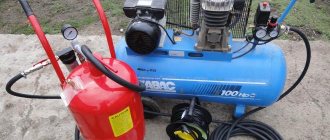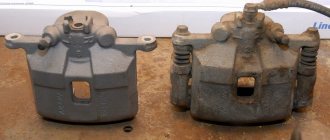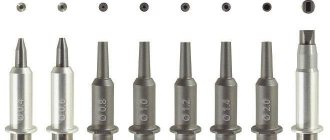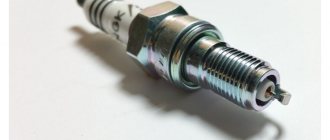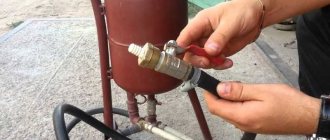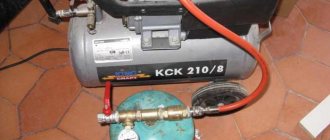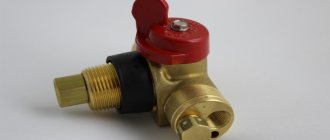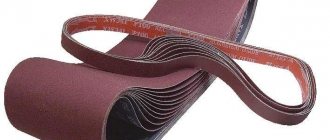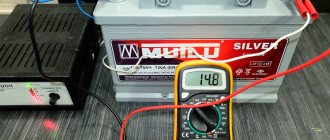With the increasing level of technical solutions, even in a small workshop it is possible to organize a workplace for sandblasting a variety of materials. This became possible both due to the appearance on the market of affordable compressors and the availability of various components and consumables, such as nozzles, oil and moisture traps, and abrasive powders.
However, to achieve high labor productivity and effectiveness, you need to select the right equipment. The compressor for a sandblasting machine must have certain characteristics depending on the surface being treated. There are also a number of recommendations for constructing the harness and other parts of the overall technical solution of the tool kit. Before reading the article, we recommend that you look at the various options for compressors for sandblasting.
Sand for sandblasting machine
Before starting work, you need to prepare not only the necessary equipment, but also special sand. You can prepare it yourself or buy it after consulting with the seller. At any hardware store you can purchase:
- Quartz sand for sandblasting (inexpensive and considered the most popular today). However, it has a significant drawback: during processing, dust rises, which is very harmful to the health of the craftsman carrying out the work.
- Garnet.
- Nickel slag.
- Corundum.
The use of quartz materials is permitted only if the room in which the treatment will be carried out is equipped with a functioning ventilation system. It is imperative to adhere to safety precautions, to work only in a respirator so that dust does not enter the human respiratory tract.
sandblasting gun
You can make not only a sandblasting gun yourself, but also sand for processing. Sequence of work:
- Prepare fine white (necessarily dry) gravel in advance.
- Sift it through a sieve. This will separate out the larger particles and leave only the smaller ones.
- Dry it thoroughly (you can use fire).
The cost of such material is low and it can be purchased in any quantity.
Sandblasting gun. Features of work
All pistols, regardless of their type, have approximately the same operating principle. The abrasive, the functions of which in most cases is performed by sand, is supplied under strong pressure. Pressure can be created by air flow or water flow.
As a result of the released kinetic energy, the particles come into forceful contact with the prepared surface, the paint coating is removed from it, the rust is removed, and the grinding process is carried out.
Sandblasting guns have different nozzle diameters, which will directly determine the speed at which sanding occurs and the quality of the work.
Sandblasting gun for compressor
You can purchase several nozzles, because each of them performs certain functions and in this case it will be much easier to achieve the desired result
The nozzle is a tool that will wear out during use, so it is important to replace it on time
When purchasing, you need to pay attention to the following characteristics:
- Diameter. It must be selected in accordance with the performance of the compressor selected for operation.
- Length. This parameter completely depends on what type of surface needs to be sandblasted. The length should also be selected if the surface to be treated is heavily soiled.
- The material from which the nozzle is made. Can be ceramic, cast iron, etc.
- Nozzle shape. Today, cylindrical nozzles are considered popular.
When choosing, you need to consider the following factors:
- Where should the surface treatment be carried out?
- What power sources are there for the device?
- How often cleaning work will be carried out.
- Surface area.
- Are there any traces of corrosion processes on the surface and how dirty is it?
How to make a blow gun for a compressor with your own hands
Why make a blow gun for a compressor when you can buy it for 300-500 rubles and use it for your own pleasure. Indeed, those who are wondering how to make a blow gun need to carefully weigh all the advantages of such an idea. Typically, handymen who are simply interested in it plan to make homemade devices. In this material we will look at how and from what you can make a blow gun or a device for inflating tires. First you need to take the necessary materials and tools, and then get to work. Their materials and tools will be needed:
- The mechanism for spraying a powder mixture from a fire extinguisher is a lever. This is an almost ready-made blowing device that needs minor modifications.
- Connecting rubber hoses and clamps for them
- Connecting fitting for the gun - it can be purchased separately, but it is needed to connect the high-pressure hose to our future homemade product
The set of tools you will need is standard. These are screwdrivers, keys, an angle grinder, a hammer and a welding machine. Instructions on how to make a blow gun with your own hands are as follows:
- First, take the mechanism from an empty fire extinguisher and separate it from the cylinder by unscrewing it
- If the fire extinguisher lever is equipped with a hose, then only minor modifications remain and the device is ready for use, but if instead of a hose there is a metal tube with a socket, then the socket must be unscrewed and a hose must be connected in its place or left as is
- Attach a fitting to the mechanism with which the high pressure hose will be connected. Its connection point is the hole through which the powder mixture from the cylinder entered the mechanism.
- The fitting has a small diameter, and the connecting hole is large, which means that in order to connect these elements, you will need a welding machine. The fitting must be welded to the inlet, after which the device is almost ready for testing
When manufacturing such a device, you need to take into account the design of the fire extinguisher mechanism, since they differ. It is best to use a mechanism from a car compressor, as it fits best. The manufacturing process does not require much time. If you need a gun for inflating tires, then instead of the standard pressure gauge, which has colored marks instead of a scale, you need to install a special air pressure gauge for compressors. It allows you to accurately monitor tire pressure. You need to attach a hose with a lock at the end to the nozzle. This completes the tire inflation gun.
It all depends on your imagination, the tools and consumables at your disposal. However, it is worth noting once again that the manufacturing process, although not difficult, is easier to buy a new blow gun for the compressor than to use a homemade one. It all depends on your preferences. There is also an advantage to homemade products - they will definitely last much longer than even the highest quality devices. The video below shows a detailed process on how to make a gun for blowing and inflating tires with your own hands in a garage.
https://youtube.com/watch?v=fjNZPzyRHos%3F
This is interesting!
From available materials you can not only make a blowing gun, but also expand the functionality of the device.
For example, you can make sandblasting from a blow gun. In conclusion, it is worth noting that if you have a compressor on your farm, it is imperative to have an air blowing gun. Any manipulations for purging or removing contaminants, not only shavings or sawdust, but also construction dust, will be performed easily, quickly and efficiently. A blower device is also used when repairing a car, when it is necessary to blow out clogged pipes, blow out dirt from the shaft where the spark plugs are located, remove dust in the cabin and especially from the air intakes, etc. This device is universal in use, so it’s worth buying it so that you don’t have to do all the work manually.
Publications on the topic
Sandblasting gun for compressor - purpose and use of the tool
How to use a spray gun correctly - the design and operating principle of the tool
Working principle of a sandblasting gun
Typical design elements of an injection type device are:
- Body with handle.
- Nozzle.
- Fitting for compressed air supply (in some designs an additional control valve is installed on the fitting).
- An internal air nozzle with an injection profile in the form of a truncated cone, the diameter of which narrows along the air flow.
- A control sleeve that provides adjustment of the current abrasive flow rate.
- A union nut or pin for attaching the internal nozzle to the body, which eliminates possible leaks of the cleaning mixture.
- Threaded bushing for connecting a tank or other container containing abrasive.
Some designs have a separate abrasive mixture dispensing unit, which is attached to the gun instead of a threaded bushing.
A sandblasting gun for an injection-type compressor functions like this. A nozzle for a sandblasting machine is mounted on the body, the diameter of which must be strictly selected with the pressure developed at the outlet of the compressor and with the diameter of the internal (air nozzle). A tank or hose is attached to the handle. Since abrasive dust easily penetrates into the lungs, the operator must work in a respirator. After this, the compressor is turned on, and the air flow pressure is adjusted using the control sleeve. To do this, you can use the following practical relationships:
- For nozzle diameters of 6 and 2 mm, respectively, the air flow should be in the range of 0.2...0.3 m 3 /min;
- For 8 and 3 mm – 0.3…0.6 m 3 /min;
- For 10 and 4 mm – 0.6…1.2 m 3 /min;
- For 12 and 6 mm – 0.9…1.8 m 3 /min.
Lower flow rates correspond to lower compressed air pressures (and smaller distances from the outlet end of the nozzle along the surface being processed).
The duration of work and the intensity of supply of the abrasive-air mixture are established experimentally depending on the adhesion strength of foreign particles to the base metal and the quality of the surface pre-treatment: it must be cleaned of dust and easily removable contaminants.
During the cleaning process, the gun is positioned at an angle of approximately 45° relative to the surface: in this case, the removal of contaminant particles will be most effective.
Choosing the right hoses
The equipment of the apparatus plays a major role in the formation of the final parameters of the air-abrasive sandblast jet. These are hoses, various connecting elements, connectors, and adapters. To ensure that the compressor power is used optimally, it is recommended:
- do not allow the diameter of the air passage channel to change along the route;
- minimize the number of transition elements;
- use durable, non-kink hoses with a diameter that is 3-4 times larger than the working diameter of the nozzle.
The length of the hose from the air station to the sandblasting gun should be kept to a minimum. A mobile industrial compressor necessarily takes this feature into account.
If we are talking about a semi-handicraft installation, it is recommended to increase the length of the hoses by extending the hose running from the compressor to the abrasive-air mixture mixing unit. You can further increase productivity, reduce downtime and obtain the desired, stable pressure for sandblasting by choosing the type of supercharger.
What can sandblasting be made from?
To understand how easy it is to make sandblasting with your own hands, it is enough to dwell on the operating features of each structural unit. In this case, the selection of available parts or finished products becomes obvious.
- Mixing unit. Sand for sandblasting and compressed air from the compressor come here from two hoses. The output is a ready-made air-abrasive mixture. In this case, no requirements, for example, the volume of the mixing chamber, are imposed on the unit. On this basis, you can use a regular plumbing tee to make it.
- Control devices. A normal manual sandblaster should be able to adjust the air flow and the intensity of the abrasive material. In this case, no requirements are imposed on the control device. At home, this role is well performed by water ball valves made of steel.
- Connection points. To connect the hoses, conventional fittings are installed on the portable sandblasting machine. They can be equipped with clamps for secure fastening. All these components are easy to buy in stores.
- Receiver. This part of the design is needed to facilitate the operation of the compressor and stabilize the pressure. You will definitely need a receiver if you want to get a powerful sandblast with your own hands. This device can be made from a powder type fire extinguisher with a large housing capacity. Another option is to make a receiver from a gas cylinder.
- Abrasive chamber. The components for its manufacture may differ depending on the type of installation being created. For example, an ejector-type mini sandblasting machine is assembled with a plastic bottle for abrasive. A pressure installation will require a durable container made from a fire extinguisher or a freon cylinder.
Two words about veterans
The last and perhaps most important (in our realities) question is whether to buy a new or used . When buying a compressor for a sandblasting machine from your own hands, you should be prepared for several rather unpleasant nuances:
- general wear and tear of the unit;
- lubricant consumption;
- reduction in passport pressure and productivity;
- increased noise and vibration levels;
- total time between failures.
All these factors may unpleasantly surprise you.
It is clear that the service life of the compressor will significantly affect its performance parameters, which may differ greatly from the declared factory ones. This, in turn, will greatly change the cost of operation, in particular the need for maintenance and lubricant replacement .
In the case of operating diesel compressors, everything is even more complicated. We are talking about a sharp increase in fuel and lubricant consumption, which will ultimately lead to an increase in the cost of work performed. It is believed that the cost of operating diesel compressors increases sharply after three years of active operation.
Sandblasting chamber
To reduce the consumption of sand, which scatters to the sides and is wasted significantly, you can use a special chamber. It is not difficult to do it yourself, although it will require time and financial investment. It is necessary to weld metal sheets into a box and install glass in the body to visualize the process. 2 holes are drilled in front, to which 2 rough permanent gloves are attached. The bottom is made of thick wire or lattice, and underneath there is a plastic or metal trench for discharging abrasives. The sandblasting gun is installed inside the chamber, which is most conveniently located on the table.
Compressors for work
Modern compressors for technological equipment are manufactured in piston or screw versions. When screw compressors operate, the gas compression process occurs due to the rotation of two screws.
Screw compressor design:
Screw compressor structure: 1 – housing; 2 – rotor screw; 3 – roller type bearing; 4 – ball bearing; 5 – bearing support; 6 – sealing gland; 7 – end cover; 8 – a pair of gears of the gearbox.
Working process of a piston compressor: 1 – suction valve; 2 – discharge valve
The process of operation of a compressor is most easily understood by considering the diagram of a piston device. Available:
- cylinder;
- piston;
- crankshaft;
- intake and discharge valves located in the cylinder head.
- When the crankshaft rotates, the piston makes reciprocating movements. In this diagram they move up and down.
- When the piston moves downwards, a vacuum is created inside the cylinder. As a result, the suction valve opens. Air from the environment enters the cylinder.
- When the bottom dead center is reached, the volume expansion process stops. The piston begins to move upward.
- The pressure inside increases. As a result, the intake valve closes.
- When the pressure increases above a certain value, the discharge valve opens. Pressurized air is forced into the exhaust pipe.
- When the pushing cycle is complete, the valves close. In the future, all work is repeated.
Structurally, industrial installations have not one, but several cylinders. Therefore, during their operation, work occurs in a smooth mode. The flywheel balances vibration.
Multi-cylinder piston compressor design:
When a screw compressor operates, air is sucked in from the environment. The profiles of the screw pair are made in such a way that when gas is pushed into the spaces between the screws, the volume constantly decreases. There is a gradual compression of the working fluid.
The cycle is completed without sudden back-and-forth movements. Wear in this design is minimal. Therefore, most users consider using screw compressor machines. Their higher reliability has been proven over time. Therefore, if you have the opportunity to choose one type or another, then it is better to opt for screw systems.
Attention! Gas compression occurs in a short period of time. Heat exchange with the environment is limited
Therefore, in calculations it is assumed that the processes of compression and pushing of air occur adiabatically (without exchanging heat with the environment). Therefore, compressed air heats up by 300...450 ⁰С.
For normal operation of compressor units, cooling is necessary. Industrial devices have a water cooling jacket. Smaller units are cooled by a fan that blows air over the finned surface of the cylinder and cylinder head.
Alternative methods for making a sandblasting machine
There are different options for creating sandblasts that can be used in a home workshop.
From a pressure washer
A sand cleaning apparatus can be constructed from a Karcher-type mini-wash or a device of another brand. A car wash creates high water pressure at low flow rates, so it is perfect for making a machine
It is important to use the finest sand of uniform dispersion, for example, well-screened river sand.
To make sandblasting, you need to assemble a nozzle for the car wash outlet pipe. You should purchase the following components:
- ceramic nozzle;
- reinforced hoses;
- cylindrical type dispenser;
- mixing block (tee of the required diameter).
Instead of air, water will be responsible for supplying sand in this sandblasting machine. Liquid under pressure will pass through the mixing unit, creating a vacuum in the abrasive supply hose. As a result, sand will begin to be thrown out with great force and perform grinding, polishing, cleaning, matting of surfaces.
From a blow gun
- plumbing tee;
- ball valve for regulating sand supply;
- outlet nozzle with clamping nut;
- plastic bottle as a container for sand.
After connecting the parts, you need to connect the gun to the compressor and carry out a test sandblasting, first pouring sand into the bottle and adjusting the intensity of work using the trigger.
From a spray gun
To create this type of sandblasting you will need a simple spray gun, as well as:
- ball valve regulator;
- plumbing tee;
- reinforced hoses;
- compressor.
To assemble the device, you need to sharpen the spray gun for a nozzle of the required size, install two hoses (for air circulation and abrasive supply) and connect the compressor. The sand supply will be started by simply pressing the spray gun trigger.
From a gas cylinder
Pressure sandblasting from a cylinder is one of the simplest but most reliable designs that you can do yourself. You need to prepare the following components:
- ball valves – 2 pieces;
- small gas cylinder;
- pipe for creating a funnel for the cylinder;
- plumbing tee;
- hoses 14 and 10 mm for supplying air and sand and fittings for them;
- clamps for attaching sleeves;
- FUM tape.
All contents are removed from the cylinder and cleaned from the inside using suitable detergents. The top of the cylinder is cut down with a grinder in accordance with the diameter of the purchased pipe. Another hole is made at the bottom to connect to the tap.
The next step is to install the faucet by welding the regulator or screwing it through an adapter tube. Attach a tee, a mixing block, and seal the threads with FUM tape. A tap is placed on the cylinder valve, then a tee. To make it easier to move the device, wheels are welded, and to improve stability, supports from corners and reinforcement are welded.
At the end of the work, connect the tubes for supplying air and sand - put fittings on the tee and the valve of the gas cylinder, while placing a 14 mm hose between the mixing block and the tee. The compressor is connected to the free branch of the tee, and a sand hose is mounted on the third end.
From a fire extinguisher
This installation is assembled similarly to a fire extinguisher. To seal the top, you need to create a plug in advance using lathes. Place a rubber sealing ring on the plug and screw it into the neck of the fire extinguisher. This hole is suitable for pouring sand. Next, you need to drill holes on the body at the top and in the bottom, having previously cleared these areas of old paint. Legs made from pipes and fittings can be welded to the bottom. After installing the tees and hoses, you can use sandblasting for its intended purpose.
Sand supply method
The abrasive can be collected directly from the attached tank or from another tank using a hose. What is the best sandblasting gun, hose-fed or barrel-fed? It all depends on the amount of work being done. For example, if you need to clean 1 - 2 m2 of sheet metal, then a regular tank will be enough. But it needs to be constantly replenished, which means downtime. The advantage is its mobility, that is, you will have to drag fewer hoses. We can say that a pistol with a barrel is intended for small-scale work in the garage.
For larger jobs, it is better to choose a hose sand supply. In this case, the hose is lowered into a sand reservoir, such as a large barrel, and the sand is fed until it runs out. This method of supplying abrasive is convenient when you need to clean a large area, for example, a car body. However, due to the hose, some of the mobility that a device with a tank has is lost. In general, this is not critical if the sandblasting machine is in our garage and we perform all the work in one place. Also, hose sandblasters have a higher air consumption and require higher pressure. If for devices with a tank approximately 3 - 4 bar is enough, then for hose devices you need 5 - 8 bar.
Application of technology
A sandblasting gun is a device for carrying out abrasive processing of various materials, surfaces, and objects. As an independent device or in conjunction with a sandblasting chamber, it is used in construction and repair, metallurgy, instrument making, the automotive industry, and a number of other industries.
The device is in demand for different types of work:
- removing rust before applying anti-corrosion compounds, other protective agents or to extend the service life of products;
- grinding wood, metal, plastic, stone, ceramics (objects, blanks, individual components) before decorating;
- cleaning from dirt and old paintwork;
- frosting glass to give an opaque effect (dishes, showers, windows);
- degreasing metal before coating with varnish or paint;
- applying drawings to glass and other materials;
- cleaning parts of complex shapes;
- restoration of art objects;
- imparting roughness to materials in order to enhance adhesion with various coatings;
- artificial aging of wood - furniture, decor, interior elements;
- cleaning the car body from dirt and old coatings before painting.
A sandblasting gun is indispensable for cleaning various curved parts: you can spend a lot of time on this process manually, and the quality of preparation of the product will not be the best. When using sandblasting, even hard-to-reach areas will become perfectly clean and sanded in a short period of time.
Advantages and disadvantages
The main advantages of sandblasting machines of this type include the following.
- Variety of price ranges for pistols. You can purchase simple budget economy class models, or you can choose expensive guns used for decorating glass surfaces and matting mirrors.
- Small tool sizes. Sandblasters come in different sizes and shapes. You can choose designs whose small size allows you to carry out surface cleaning work in hard-to-reach places and confined spaces.
- Simplicity of design. You can assemble these pistols yourself at home.
- Easy to use. Sandblasting is easy to operate. It comes into motion thanks to the control panel or when you press the trigger.
- Sandblasting models can be assembled yourself.
- Savings on the cost of cleaning and surface preparation for finishing carried out using traditional methods.
- Saving time and labor costs. Removing peeling plaster or floor varnish from walls is much faster when using a sandblasting gun than doing manual cleaning work.
There are not many disadvantages to using sandblasting equipment. It can be noted that all pistols have the following disadvantages.
They have a fairly short service life. At the same time, it will be lowest for budget devices, compared to the service life of more expensive models. The devices are distinguished by a fairly high level of noise produced during operation. When performing surface treatment with sandblasting, be sure to use a protective suit, helmet and goggles so as not to cause harm to health. The formation of a huge amount of dust, the clouds of which can cause significant harm to the health of nearby people
In addition, dust settles on surfaces and objects located close to where the gun is used. By taking all necessary precautions, you can reduce the level of adverse health effects. By removing or covering objects with a special film, you can protect them from exposure to dust and reduce the time spent on subsequent cleaning after sandblasting.
What compressor is needed for sandblasting and criteria for the correct choice
Sandblasting machines are increasingly being used to treat surfaces. Even in the relatively recent past, such technology was used only at large enterprises, where the volume and required pace of work carried out was very large. And the dimensions of such installations were, to put it mildly, impressive, with their no less significant cost, which, in turn, made their purchase and operation by small firms or workshops, if not completely impossible, then at least very unlikely. But fortunately, everything is changing. Over time, less bulky and less expensive sandblasting machines .
Today, the range of such equipment is impressive. From a huge number of possible offers, you can easily choose a device based on the intended work and your financial capabilities. You can find sandblasting in almost every garage cooperative. Often this is the child of an inquisitive mind and the skillful hands of some “homemade artist”. Any scrap metal is used, from old saucepans and rusty pipes to gas cylinders and old barrels of quite impressive volume.
There is an opinion that sandblasting is used mainly to clean rust from metal. Actually this is not true. The scope of application of these devices is very wide and metal processing is only one of the options. It can be used to clean stone, concrete and brick walls. Sandblasting is also used to apply designs to glass and mirrors, which has recently been very often used in the manufacture of expensive custom-made furniture.
But the operation of any sandblasting machine, factory-made or home-made, uses compressed air , and, therefore, a compressor is needed. And if you decide to do sandblasting, it wouldn’t hurt to figure out which compressor is worth purchasing.
It is unlikely that you will be able to make it yourself, which means you will have to buy it. Considering the considerable cost of compressors, you need to accurately determine its parameters. In the case of sandblasting machines, their productivity and the quality of the work performed, and ultimately the time you spend on this work, depend on this. There is a wide selection of compressors for sandblasting machines.
Main components of sandblasting machine
Homemade sandblasting is assembled on the basis of standard schemes, differing in the method of supplying sand to the contaminated part. Despite the existing design differences, the components for both options are the same:
- compressor - a device for pumping air mass;
- a receiver necessary to create the necessary air supply;
- abrasive tank;
- gun - the main device designed to supply an abrasive mixture to the surface to be cleaned;
- hoses.
Design of a sandblasting machine
The device, regardless of the assembly scheme, forms a combined outgoing flow of air and abrasive. When assembled according to a pressure circuit, sand under the influence of pressure enters the outlet pipe, in which it is mixed with the air supplied from the compressor. To form a vacuum in the abrasive supply channel in ejector devices, the Bernoulli effect is used. Sand is fed into the mixing zone under the influence of only atmospheric pressure.
The existence of many options for sandblasting manufacturing schemes is explained by the possibility of creating it from materials at hand, which often seem unnecessary. To understand the essence of the process, it is enough to consider the general principles of assembly.
A spoon of tar
The air, coming in impulses, knocks the unevenly distributed abrasive into lumps , as a result of which the sandblaster begins to “spit.”
To solve this problem, you have to use a fairly large receiver and, as a result, a compressor with greater capacity. Another unpleasant moment is a significant release of compressor oil from the pistons. But you can fight it too. To do this, oil and moisture traps are installed in the air duct. This is a common problem. The occurrence of moisture-oil condensation can lead to failure of the sandblasting apparatus, and in some cases, its complete failure.
The presence of foreign liquids in the air path leads to the abrasive sticking together and losing its flowability. This, in turn, causes problems with the system and can lead to damage or failure of the device. Moisture on the shot sharply accelerates its oxidation, and oil on the surface being cleaned is an extremely unfavorable factor.
The operating principle of a sandblasting gun and the main abrasives
Cleaning, grinding, polishing or matting of various surfaces occurs under the influence of a powerful stream of sand, which moves due to the pressure of compressed air. The sand is supplied in a narrow stream, the direction of which can be adjusted. As a result of sandblasting, the excess layer is removed from the surface, it becomes smooth or, on the contrary, rough (depending on the type of abrasive).
Most often, quartz sand of various fractions is used as an abrasive material: fine sand perfectly polishes the base, coarse sand removes stubborn dirt and rust, creates a network of grooves and improves adhesion to coatings. Sandblasting with river sand is even cheaper, however, it does not make sense to use it in guns with an abrasive recycling system: the loose mixture is destroyed upon impact with the surface and cannot be reused. Metal shot, nickel slag, cooper slag, and corundum do not produce dust and provide much better processing quality, but their price is an order of magnitude higher.
Required parameters
First of all, it is worth remembering that sandblasting performance directly depends on the amount of air and maximum pressure that the compressor is capable of producing. It is believed that to operate with a nozzle with a diameter of five millimeters, a productivity of 500 l/min is sufficient, but experts recommend 700–1 thousand l/min , with a pressure of around 6–8 bar. But do not forget that this figure is a recommendation. The required optimal pressure and volume in each specific case will differ and depend on several factors:
- abrasive hose diameter;
- air hose diameter;
- length of highways;
- nozzle diameter;
- quality and fraction of the abrasive used.
Based on these criteria, you can estimate the approximate consumption of abrasive , and therefore the productivity of the device as a whole.
A larger volume of air allows the use of larger diameter nozzles, which, in turn, makes it possible to increase the cleaning spot and, consequently, the speed of surface treatment. As for the pressure, it can be different, depending on the type of surface being cleaned:
- for cleaning concrete, stone or brick – 3–5 bar;
- for cleaning metal surfaces – 6–8 bar;
- for work on cleaning coatings resistant to mechanical damage – 9–12.
Approximately 12 bar, can be used if it is necessary to deliver the air-sand mixture to a height of more than sixty meters. Although, in such cases it is recommended to increase the distance due to the length of the air hose.
Varieties
There are various models of equipment in stores. To choose a compressor for sandblasting, you need to know what types they are divided into. There are two types of compresses, which are classified according to the type of action:
- piston;
- screw.
Based on the type of power supply, there are two types of equipment:
- electrical;
- gasoline and diesel.
Piston
Piston compressors are considered the most common and popular. They are suitable for small amounts of work. They are used in garages, car services, and own workshops. They have certain features:
- The air is not supplied in a uniform flow, but in jerks.
- When choosing a piston sandblasting machine, preference should be given to oil-based models. Oil droplets may enter the air supply hose.
The design overheats during prolonged operation and requires frequent shutdown to cool down. As standard, this equipment is not suitable for connection to a sandblaster. To improve performance and increase efficiency, you need to purchase a compressor with an assembled air station. This design stabilizes the pressure, allows the engine to stop on its own to cool down and prevents oil from entering the air channel.
Screw
Screw-type compressor units supply air evenly. There are no jerks that prevent the surfaces from being evenly treated with abrasive material. Other features of the screw apparatus:
- Stable operation for a long period of time.
- No additional maintenance or fine adjustments are required.
- Does not emit strong vibrations during operation.
However, despite such advantages, screw installations have not become widespread due to their size and cost. Most often, screw models are used to power several sandblasting machines.
Electrical
They are considered the most popular models that can be found on sale. However, equipment connected to the general power supply network requires a large amount of energy when processing massive structures. Because of this, the use of electrical devices is only advisable for small workshops, private houses and garages.
Electric compressor
Diesel and petrol
Equipment powered by liquid fuel has a number of advantages:
- Operation is not affected by low temperature. Diesel systems have a special start button for winter.
- When processing massive structures, they are more economical than electrical devices.
- Does not require a network connection. Can work indoors without electricity
Equipment running on diesel and gasoline is more powerful than electric models. Also, we must not forget about the cooling system. When using internal combustion engines, it is more thoughtful and allows you to work with the equipment for a long time without turning it off.
This is interesting: Protecting aluminum from corrosion (video)
Advantages and disadvantages
In most cases, a cooler is sufficient to clean the air from condensation, but sometimes special refrigeration systems are used. When working on the road, the question often arises: what type of compressors should I give preference to, diesel or electric?
Both the first and the second have several positive and negative features that should be taken into account when choosing equipment.
One of the indisputable advantages of diesel engines is autonomy. You are absolutely not tied to power sources. Plus, most of these compressors have a built-in automatic engine speed control system, which allows you to save fuel while reducing air consumption. A similar system for electric compressors is much more expensive. However, the cost of fuel is quite high. In this regard, diesel compressors should be used exclusively in cases where there is no access to an industrial power supply network.
Selection of main compressor characteristics
In many reference materials you can find data that the minimum compressor performance threshold should be 500 liters per minute at a pressure of 5 bar. However, almost nowhere is the truth told. You can choose a compressor for sandblasting with such characteristics even without the necessary piping. However, at the same time:
- the sandblasting machine will only be able to work with limited types of surfaces and coatings;
- Long-term use of the sandblasting unit is not ensured - pauses are required to cool the engine;
- a sandblasting compressor will display all its design features, in particular, rotary models will inevitably supply air in jerks.
Based on practical experience and recommendations from leading manufacturers of professional equipment, an honest assessment of the minimum requirements for an injection system can be made. The compressor must necessarily work with a receiver piping. With the correct choice of its volume, it is possible to achieve the required continuity of operation, even if a piston-type supercharger is used.
The basic requirements for choosing a compressor for a sandblasting machine depend on the materials and nature of the coatings with which you will have to work:
- for processing concrete, chamber surfaces, wall brickwork, the minimum operating pressure should be 3 bar;
- when working with metal, the compressor must provide a pressure of 6 bar;
- To remove tough coatings, the recommended pressure is 9 bar.
The maximum you should aim for if you want to choose a compressor for sandblasting with high versatility is a pressure of 12 bar. In the recommendations under consideration, it is assumed that the diameter of the working nozzle is 5 mm, and the pumping level is 800 l per minute.
Advice! Today, many manufacturers offer ready-made air stations for sandblasting machines, providing performance levels from 700 to 1000 liters per minute with pressures up to 12 bar. It is this kit that is recommended to be purchased to achieve optimal performance and ease of use in a workshop environment. For industrial purposes, it is recommended to choose a device with a capacity of 3000-5000 l/minute and an outlet pressure of up to 10 bar. Typically these are screw type compressors.
Is it worth buying a used compressor?
The secondary equipment market is very attractive with low prices, flourishes with sellers’ assurances in the “turned on once for testing” style, and pleases with a variety of compressors for sandblasting. However, when looking at used equipment, you should not be swayed by external impressions. Many aftermarket products undergo cosmetic pre-sale preparation. They look great, but this does not affect the nature of the work. If a difficult financial situation forces you to pay attention to used compressors, it is worth remembering some facts.
- Over time, the compressor parameters inevitably drop. Therefore, if you need to buy equipment with high performance, it is better to check it carefully using flow meters and other measuring devices.
- Diesel compressors are characterized by the greatest wear. The piston group of the engine is destroyed due to the constantly high pressure in the chambers. The engine consumes more fuel with less power output and has difficulty starting as the air temperature drops. Used equipment of this type will require high maintenance costs, constant cleaning, and repairs.
- The aftermarket screw compressor is a real dark horse. The equipment may not meet the stated specifications. In addition, worn bearings or rotor blocks will require expensive repairs or replacement, involving specialists or proprietary service. It’s even worse if stopping the compressor causes work to stop and orders to be missed.
- Equipment with uncommon types of components and lubricants is not the best choice. This is especially true for products of Chinese industry and unknown brands. If such a compressor fails, repairing such a compressor can be very difficult or impossible due to the unavailability of spare parts.
Manufacturers of compressors for sandblasting (if we are talking about serious companies) always declare the duration of normal operation for their equipment. Typically this period is 7-10 years. Based on this parameter (based on the date of sale or release), you can select a compressor on the secondary market.
Advice! You cannot rely only on the nominal service life when assessing the rationality of a purchase. The compressor could operate in critical conditions, overheat, use poor quality fuel, or operate with undesirable power parameters. Therefore, each device must be checked as carefully as possible, paying attention to the wear of moving parts, air flow parameters, the condition of the windings and other key details.
